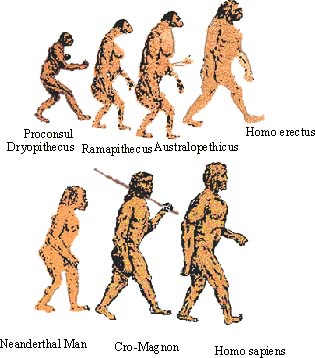|
PinkMonkey Online Study Guide-Biology
12.2 Ancestral forms of Homo sapiens
As mentioned earlier, the palentological (fossil) record
for human evolution is not continuous. Ever since the theory of evolution
become scientifically acceptable, biologists and anthropologists have
been trying to find the ‘missing link’, the species that would
bridge the gap between humans and the great apes which are the closest
living relatives of humans. The fossils collected from various
regions indicate possible trends in human evolution. Some important ancestral
forms of Homo sapiens are described below.
(1) Dryopithecus
It appears from fossil evidence, that humans and apes
(Hominids) have both descended from a common ancestor, called Dryopithecus,
that lived 20 million years ago (Miocene epoch). The first Dryopithecus
fossils were found in 1930 on an island in Africa’s lake Victoria by Dr.
Lewis Leakey. Later on they were also found in Africa, N. India, China
and Europe. The Dryopithecus were first described as Sivapithecus,
Proconsul and Ramapithecus. Dryopithecus were contemporary
to another genus, Pliopithecus. These appear of be ancestors to
apes and humans. Important anthropoid characters of Dryopithecus
included a somewhat flattened face, a shortened jaw, enlarged incisors
(typical of apes, but not human), arms and the legs of the same length
and must have assumed a semi-erect posture on the ground and were more
bipedal than the other apes.

Figure 12.3 Human Evolution
(2) Australopethicus
Australopithecus africans represents the next
known step in human evolution. The fossil remains from Africa belonged
to early Pleistocene era (1.2 - 3 million years ago) and named
by Raymond Dart in 1924. It weighed 40-60 pounds, bipedal form of primates,
walked in an entirely erect posture, a distinct lumbar curve and had human-like
teeth. The dental arch was a smoothly rounded parabola. However, Australopithecines
had jaws and teeth larger than those of modern man. It had an ape-brain
(capacity 450-700 cc.) rather than a human brain.
They were living in groups assumed to be using
tools (made by chipping pebbles) since the fossils are often found
with piles of bones of hares, birds, baboons. This indicates that they
were true hunter scavengers, who actually hunted animals they ate. Another
form of hominid, Australopithecus robustus, appeared later, weighed
150-200 pounds, walked erect and had a brain size similar to that of the
ape.
Another type of hominid creature lived in the place and period as Australopithecus and was also bipedal, but had a larger brain and used tools. It was placed in genus Homo - its full name is Homo habilis (habilis = mentally skillful).

|
Table of Contents
12.0 Introduction
12.1 Palaeontological Evidences - Our Ancestors
12.2 Ancestral Forms of Homo Sapiens
Chapter
13
|